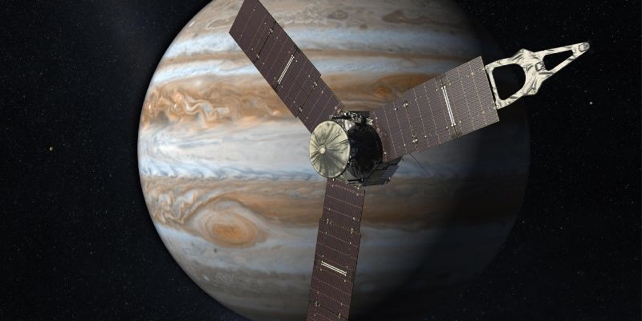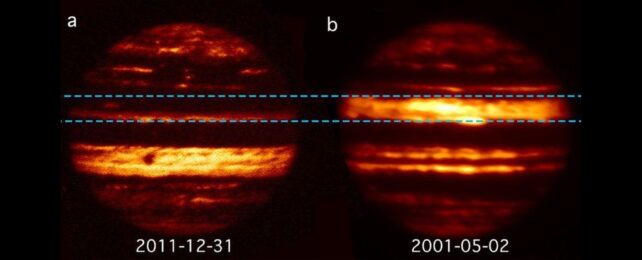Tigers may not change their stripes, but Jupiter sure does. The giant planet's surprisingly neat, alternating bands of dark and light clouds periodically change their appearance, but the reason for these cyclic variations is a mystery.
Now, after studying data on Jupiter's magnetic field collected by the Juno probe, a team of scientists from Japan, Spain, and the UK think they've cracked it. The changes seen in Jupiter's stripes coincide with magnetic oscillations inside the gas world.
"It is possible to get wavelike motions in a planetary magnetic field which are called torsional oscillations," explains mathematician Chris Jones of the University of Leeds in the UK.
"The exciting thing is that when we calculated the periods of these torsional oscillations, they corresponded to the periods that you see in the infrared radiation on Jupiter."

From a distance, Jupiter appears as serene as a sunrise of pale creams and burnt caramels. These darker stripes are known as belts, the paler ones as zones.
Quiet though they seem, the belts and zones are part of Jupiter's wild weather system. They circle the giant planet in opposite directions – belts travel against Jupiter's rotation, zones travel with it – and at different altitudes. The belts are regions of upwelling, so the cloud tops in the belts are higher than the cloud tops in the downwelling zones.
In infrared, the color scheme reverses. The light bands become dark and the dark bands shine brightly, suggesting that the belts have much thinner cloud covering than the zones.
Earth has similar (if fewer and weaker) alternating belts of atmospheric circulation, suggesting there is some similarity in the way each world generates these atmospheric features.
Yet Jupiter's weather is so very different from that on Earth that it's impossible to extrapolate what one planet does onto the other. What's more, Jupiter has cyclic variations in its clouds linked to variations observed in infrared data from 50 kilometers (30 miles) below the surface that left scientists puzzled.
"Every four or five years, things change," Jones says. "The colors of the belts can change and sometimes you see global upheavals when the whole weather pattern goes slightly crazy for a bit, and it has been a mystery as to why that happens."
Juno has been studying Jupiter since 2016, and has been collecting a lot of data on Jupiter's various structures and properties. One of those is the planet's magnetic field – a huge magnetic structure generated by Jupiter's dynamo, a convecting and conducting fluid rotating in the planetary interior that converts kinetic energy into magnetic energy.
Earth has a dynamo, too. One thing Earth's dynamo produces is magnetic torsional oscillations – a type of magnetic "wave" that oscillates in and out – symmetrical around the planetary axis, influenced by rapid rotation.
By studying years' worth of magnetic field data collected by Juno, Hori and her colleagues were able to identify the signatures of similar oscillations in Jupiter. And, excitingly, these seemed linked to the changes in the planet's stripes and infrared variations.
"We here propose," they write in their paper, "that torsional oscillations give rise to a shear that disrupts the slow convective flows in the deep interior that carry the heat flux towards the visible troposphere."
This could cause a major disruption to the weather, and alter the patterns of upwelling and downwelling in the Jovian clouds. The team also tracked a highly concentrated region of the magnetic field called the Great Blue Spot near the equator. They found it is slowing down, suggesting that a new oscillation is beginning.
Continuing to observe the planet to see how the clouds change in the near future could help the team validate or refine their theory, and understand how it happens.
"There remain uncertainties and questions, particularly how exactly the torsional oscillation produces the observed infrared variation, which likely reflects the complex dynamics and cloud/aerosol reactions. Those need more research," Hori says.
"Nonetheless, I hope our paper could also open a window to probe the hidden deep interior of Jupiter, just like seismology does for the Earth and helioseismology does for the Sun."
The research has been published in Nature.
